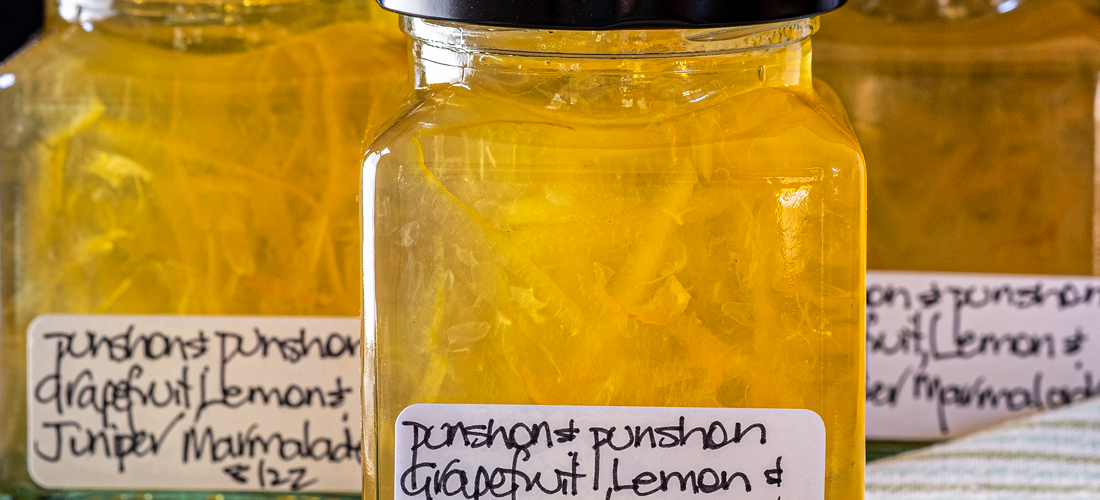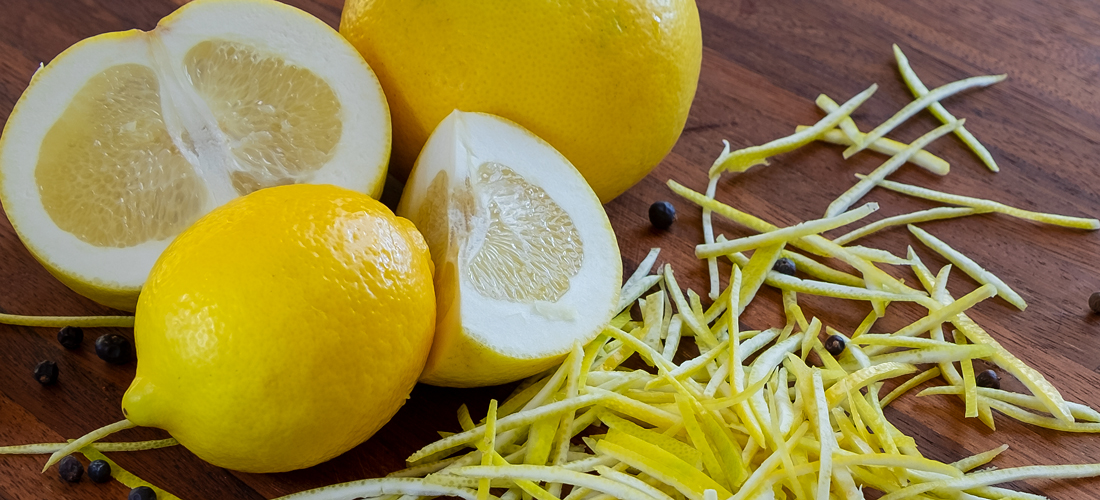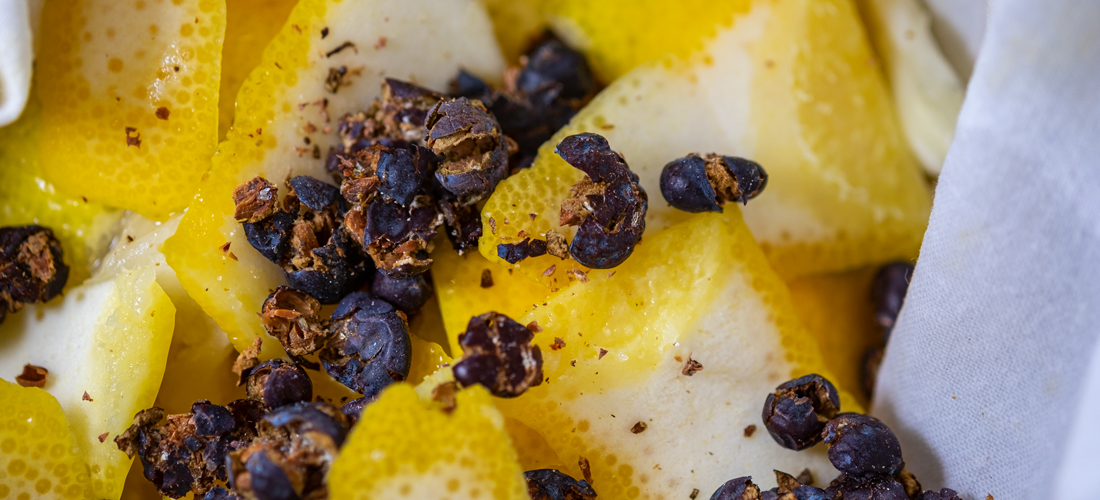Grapefruit & Juniper Berry Marmalade
- Jams, Jellies & Marmalades

Marmalade officiado’s, a new breakfast treat awaits. Junipers sweet taste and piney aroma is well suited to the citrusy and musk flavours of grapefruit. You won’t find this on any supermarket or gourmet food store shelf. It’s definitely worth making a batch when grapefruit is abundant and gifting to friends and family that are marmalade devotees. Buy whole juniper berries and store in a sealed container as the oils that give them their characteristic flavour evaporates easily.
"A wise bear always keeps a marmalade sandwich in his hat in case of emergency"
Paddington Bear
- Preparation Time:
- 30 minutes
- Cooking Time:
- 1 hour
- Quantity:
- 6 x 325 ml jars
INGREDIENTS
- 3
- Grapefruit, large
- 2
- Lemons, medium
- 6
- Juniper berries, whole
- small knob
- Butter
- 2.5 lites
- Water
- 2 kg
- Sugar, white

METHOD
Wash the skin of the grapefruit and lemons to remove any dirt and debris from the garden or wax if they have been commercially grown. Using a vegetable peeler, remove the rind in thick pieces. Cut the grapefruit and lemons in half and juice. Reserve the pips to make the pectin bag in Step 3.
Remove any excess pith, particularly if using a grapefruit or lemon variety that has a thick layer around the fruit. Discard this pith and slice the remaining fruit membrane. This will be included in the pectin bag.
Place a small knob of butter in the bottom of the preserving pan and pour the grapefruit and lemon juice in.
Lightly crush the juniper berries in a mortar and pestle or place in a paper bag. Cover with a tea towel and crush with a rolling pin or kitchen mallet.
Place the pips, sliced grapefruit and lemon membrane and crushed juniper berries into muslin or calico and tie up with kitchen string to make a cloth bag. Leave a sufficiently long tail on the string so that it can be tied to the preserving pan handle. Place cloth bag into the preserving pan and tie to the handle. More detail on making a pectin bag is provided in the Notes section below.
Cut the grapefruit and lemon rind into thin or thick shreds depending upon your liking. Place the shreds and water into the preserving pan.
Cover and simmer gently for approximately 30 minutes or until the peel is very tender. To test if it is cooked sufficiently, take a piece of peel between your thumb and first finger and rub them together. The peel should break down easily to almost nothing.
To warm the sugar, place in a stainless-steel bowl and put into a low oven for approximately 15 minutes. Refer to the Notes section below
When the peel is cooked, remove the cloth bag from the pan and allow to cool slightly before squeezing it over the pan. This will help to extract any pectin left in the bag.
Stirring constantly over a low heat add the warmed sugar in 3 batches ensuring the sugar is dissolved before more is added.
When the sugar is completely dissolved, bring to boil quickly, and boil rapidly, uncovered, for 10 – 15 minutes or until the setting point is reached . Do not stir during this time but keep an eye on the pan so that as the marmalade foams and rises in the preserving pan it does not boil over.
-
Remove the pan from the heat and place on a wooden board. Skim off and remove any scum using a stainless-steel spoon or ladle. Leave to cool for approximately 10 minutes, then stir and use a funnel to pour into dry sterilised screw cap sealable bottles.
Fill to approximately 2.5cm (1 inch) from the top of the bottle and seal using your preferred method.
-
Label when cold and store in a cool dark place in the kitchen or pantry.
Allow the marmalade to mature for at least 2 weeks before eating.
NOTES
- Use fresh citrus picked recently as the pectin content is likely to be higher. Pectin is concentrated in the seeds, pith, peel, and cores of fruit. Don’t discard them. They are invaluable in marmalade making as it is the ratio between the fruit acids, pectin and sugar that makes them set.
- To make a pectin bag, drape clean sterilised calico or muslin cloth over a bowl. Place the pith, pips, and other ingredients, as specified in the recipe, in the cloth. Gather up the ends and close the bag by tying it up with kitchen string. Allow room, between the tie point and fruit mass, so the water can bubble through easily. This helps to extract as much pectin as possible from the mixture. It’s now ready to use. Discard the fruit once the bag has been removed from the preserving pan. Wash, dry and keep the cloth for the next batch. My tea towel draw has a range of different sized cloths that are on hand for my jam and marmalade experiments.
 Juniper berry & fruit in pectin bag
Juniper berry & fruit in pectin bag- The juniper flavour will be extracted as it cooks in the pectin bag. The amount of berries can be increased or decreased depending on the final strength of flavour you want.
- If the fruit contains a lot of pith, only put a small amount in the pectin bag, otherwise the marmalade can take on a bitter taste.
- To wash the fruit, I use a pair of Skrub’a gloves. A wonderful invention, they are made of a slightly course material that magically scrubs fruit and vegetables with the greatest of ease. Easy to wash and dry, they are an indispensable item in my kitchen. Special thanks to my very dear friend Sue, who found them in a cookware shop.
- To test if the peel is cooked, squeeze a piece between the thumb and finger; it should squeeze easily to a mush .
- To warm the sugar, put the recipe quantity in an oven proof container and place in a preheated 120 degrees C oven for approximately 10 minutes. The sugar should be warm to touch, not hot. Warmed sugar, dissolves quickly and a rapid boil until the setting point is reached helps to preserve the fresh citrus flavour.
- If you don’t have a preserving pan, use a large pot, preferably stainless steel. Ensure there is enough space available in the pot for the mixture to double in size while it is rapidly boiling.
- Any stray pips that managed to end up in the pot will rise and fall while the marmalade is boiling. As the cooking progresses, they will become increasingly darker, making them easier to see. Remove while you can so that they don’t end up in the jar. If you are entering your marmalade into any competitions, judges will mark your submission down if they see them.
Happy marmalading
